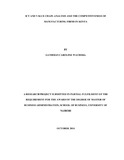| dc.description.abstract | The purpose of this study was to investigate the influence of ICT and value chain analysis on the
competitiveness of manufacturing firms in Kenya. Specifically, the study sought to fulfil the following
objectives: To determine the influence of ICT on the value chain of manufacturing companies in Kenya;
To determine the influence of ICT on the competitiveness of manufacturing companies in Kenya; To
determine how manufacturing firms in Kenya best leverage on ICT in order to increase their margins.
This study was justified by supply chain and value chain revolution that has been fuelled by
technological wave which has led to a reorganization of how industries, specifically those in the
manufacturing sector, leverage on their value chains to outpace the competition. This research problem
was studied through the use of a descriptive survey design. The survey was cross sectional in nature
since it covered a sample of 24 firms in various segments of the manufacturing industry in Kenya. The
research employed sampling technique and this is validated by the vast number of firms in the
manufacturing industry. The study used both primary and secondary data. Primary data was collected
using semi-structured questionnaires to Processing Managers of the firms in question. The data and
information obtained through the questionnaires was first checked for completeness and consistency
and then analysed based on descriptive statistics. These were then presented using tables, pie charts
and bar graphs for easier interpretation. Findings indicate that a large number of firms sampled used
some element of technology in managing their value chains and supply chains. To enhance the value
chain management, most of these firms used relatively limited ICT systems which included a blend of Ecommerce,
Decision Support Systems and in some case third party logistics (3PL) as well as Electronic
Data Interchange manoeuvres custom made to their specific requirements. The main problems that
emanated from using such systems included integration problems with both their systems, their
supplier’s systems and their customer’s systems. Other challenges cited in this study include, hidden
costs which become evident after the contract has commenced, problems in integration with suppliers
and customers systems, low budget spend for ICT, limited initiative to manage the supply chain better
and inadequate policy regarding value chain and ICT for most of the study subjects. Infrastructural
challenges also came to the fore, which were augmented by constrained information provision as well
as educational challenges. Another association identified was one where companies that had higher
turnovers had a higher budgeted spend on ICT in their value chain, which is an indication that ICT
boosted competitiveness for these particular firms. The implication of this study is that ICT does
influence the value chain as well as the competitiveness of manufacturing firms and thus firms have the
advantage of fully utilizing various ICT systems depending on their particular needs in order to fully
maximize ICT in their value chain as well as to boost their competitiveness relative to their competitors. | en_US |

